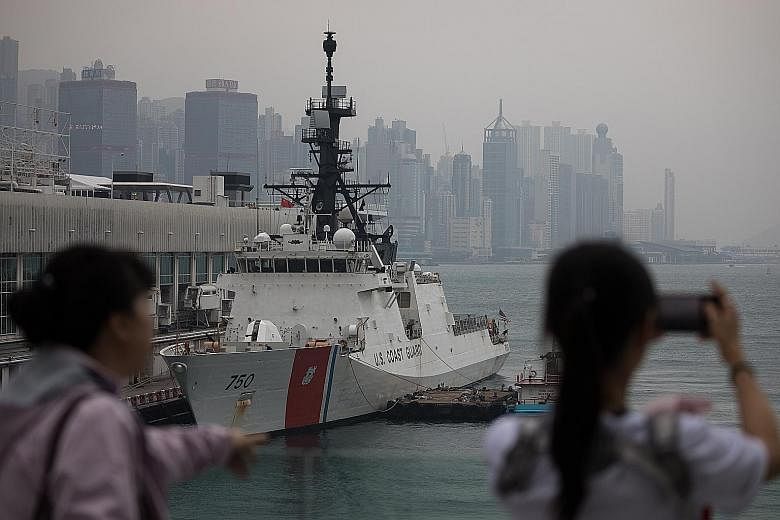WASHINGTON • As a US Coast Guard cutter sailed through the East China Sea last month, Chinese vessels shadowed it on the high seas, US service officials said. It was a reminder to the Americans of where they were: in a strategic area about 300km from China's shores.
The situation underscored the evolving American response to the rise of China and the role of the US Coast Guard, which typically operates missions closer to home.
The Coast Guard is increasingly orienting itself towards China, senior officials said, by deploying new cutters, re-positioning older ones and dispatching service members to countries such as Vietnam and Sri Lanka to help train those nations' coast guards.
Admiral Karl Schultz, the Coast Guard commandant, said that as the US Defence Department shifts its focus to competing with Russia and China, the US Navy is "oversubscribed". The factors he cited include "realities in the South China Sea" and the loss of two Navy destroyers involved in deadly collisions in 2017.
"The Coast Guard brings some capacity to that equation," Adm Schultz said in an interview. "The Coast Guard brings some authorities below the threshold of war. We're US warships, but we look different, with a white hull and an orange stripe."
The deployment of the US Coast Guard Cutter Bertholf to the Asia-Pacific region from Alameda, California, in January marked an expansion of Coast Guard operations there.
The vessel, part of the service's growing fleet of modern cutters, is under the control of the US Navy's 7th Fleet in the Asia-Pacific region during the deployment, despite the Coast Guard being part of the Department of Homeland Security.
The Bertholf has carried out several missions that are typically assigned to the Pentagon, including a high-profile transit of the Taiwan Strait last month alongside the USS Curtis Wilbur, a Navy destroyer, that was meant to demonstrate that international waterways near China remain open.
More recently, the Bertholf made a port stop in Hong Kong on April 15, the first time the US Coast Guard has visited the Chinese territory in 17 years. The ship has carried out sanctions-enforcement operations in the East China Sea, preventing illegal ship-to-ship transfers of cargo meant for North Korea.
The deployment of the Bertholf marks the first time in years that the US Coast Guard has deployed a large vessel to the Asia-Pacific region. The service has committed to the deployment later this year of another similar cutter, the Stratton, which will focus on training partner nations in the Asia-Pacific to patrol their own waters, said Vice-Admiral Linda Fagan, who leads Coast Guard operations in the region.
The Coast Guard did not want the Bertholf used "solely like a combatant" ship if it was deployed to the Pacific under Navy control, Vice-Adm Fagan said she told Defence Department officials.
There also was a desire to show that national security cutters have "interoperability" with Navy ships, she said.
The US Coast Guard also can provide deep insight into such areas as search-and-rescue operations and fisheries enforcement.
Air Force Brigadier-General Dagvin Anderson, the deputy director of operations for US Indo-Pacific Command, said in a statement to The Washington Post that the Coast Guard "brings deep knowledge and unique capabilities" important to partners and allies in the region. The service's law enforcement authorities also complement the Defence Department's objectives, he said.
The Coast Guard's involvement in the region has included transferring a decommissioned cutter, the former USCGC Morgenthau, as well as aluminium shark boats, to the Vietnamese coast guard. The vessels will assist Vietnam in stopping smuggling, piracy and illegal fishing, according to a statement released by the US Embassy in Hanoi.
The United States handed over another decommissioned Coast Guard cutter, the former USCGC Sherman, to the Sri Lankan navy last year.
The US Coast Guard is in the process of adding fast-response cutters - 47m ships manned by a crew of 24 - in the Pacific. Three will be based in Hawaii and three in Guam. One already has sailed about 3,800km west from Honolulu to the Marshall Islands.
The deployments of the national security cutters come as the US Coast Guard wrestles with interdicting more than 180,000kg of cocaine per year closer to home, mostly off the coast of Colombia.
Vice-Adm Fagan acknowledged that cutters in the Asia-Pacific region might otherwise be deployed there, where the service has sought to put more vessels.
Mr Lyle Morris, a Rand Corp analyst who studies security issues in the region, said the US Coast Guard has been involved in Asia "in a minor way" for decades but is now responding to requests from smaller nations in the region to control their own territorial waters.
"They see the role of law enforcement vessels and coast guards as relatively non-escalatory, or less escalatory, than a navy," he said.
The need for the US Coast Guard goes beyond countering China, he added. "China is a factor, and an increasing factor, but I would say that it's not the only factor," he said. "The biggest constraint for these countries is the money. They just don't have the money to buy a lot of new vessels."
WASHINGTON POST

